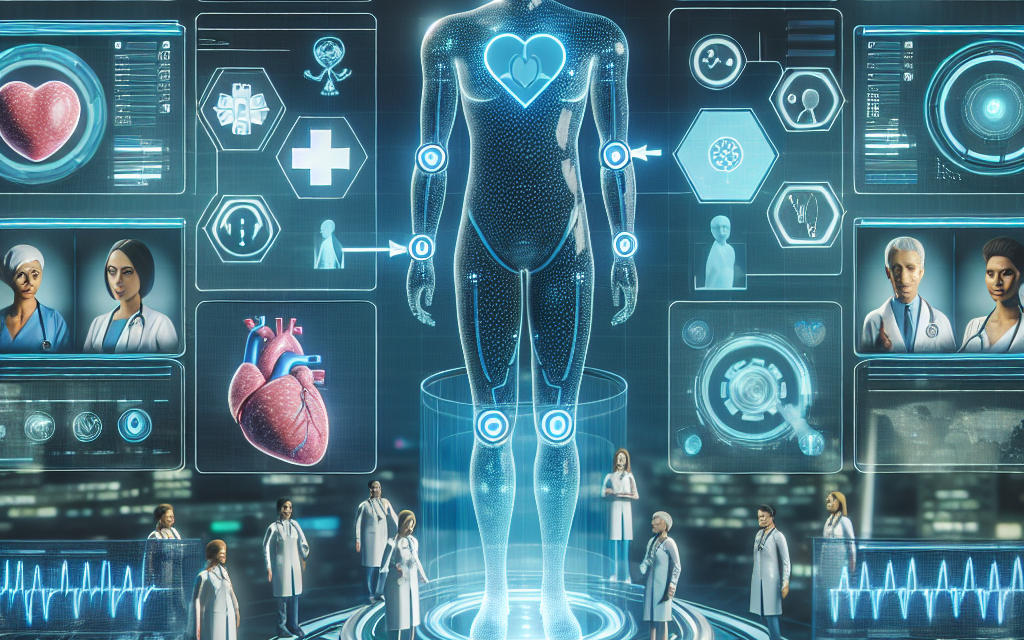How AI is Revolutionizing Remote Patient Monitoring Technology

In recent years, the healthcare industry has witnessed a significant transformation driven by technological advancements. Among these, Artificial Intelligence (AI) has emerged as a pivotal force, particularly in the realm of remote patient monitoring (RPM). As healthcare systems worldwide grapple with increasing patient loads and the need for efficient care delivery, AI-powered RPM solutions offer a promising avenue to enhance patient outcomes, reduce costs, and improve overall healthcare efficiency. This article delves into the multifaceted ways AI is revolutionizing remote patient monitoring technology, exploring its impact on patient care, healthcare providers, and the broader healthcare ecosystem.
The Evolution of Remote Patient Monitoring
Remote patient monitoring has evolved significantly over the past few decades. Initially, RPM was limited to basic telehealth services, where patients could consult with healthcare providers via phone or video calls. However, the advent of AI has transformed RPM into a sophisticated, data-driven approach that leverages advanced algorithms and machine learning to monitor patients’ health in real-time.
AI-driven RPM systems can collect and analyze vast amounts of data from various sources, including wearable devices, electronic health records (EHRs), and even social media platforms. This data is then processed to provide actionable insights, enabling healthcare providers to make informed decisions about patient care. The integration of AI into RPM has not only improved the accuracy and efficiency of monitoring but has also expanded the scope of what can be monitored remotely.
One of the key benefits of AI in RPM is its ability to predict potential health issues before they become critical. By analyzing patterns in patient data, AI algorithms can identify early warning signs of conditions such as heart disease, diabetes, and respiratory illnesses. This proactive approach allows for timely interventions, reducing the risk of complications and hospitalizations.
Moreover, AI-powered RPM systems can personalize care plans based on individual patient needs. By considering factors such as age, medical history, and lifestyle, these systems can tailor recommendations and interventions to optimize patient outcomes. This level of personalization is particularly beneficial for managing chronic conditions, where ongoing monitoring and adjustments are crucial.
Enhancing Patient Engagement and Compliance
One of the challenges in healthcare is ensuring patient engagement and compliance with treatment plans. AI-driven RPM solutions address this issue by providing patients with user-friendly interfaces and personalized feedback. By making health monitoring more accessible and engaging, these systems encourage patients to take an active role in managing their health.
AI-powered RPM platforms often include features such as gamification, where patients can earn rewards for meeting health goals, and virtual coaching, where AI-driven chatbots provide guidance and support. These features not only make health management more enjoyable but also help patients stay motivated and committed to their treatment plans.
Furthermore, AI-driven RPM systems can send reminders and alerts to patients, ensuring they adhere to medication schedules and follow-up appointments. This level of automation reduces the burden on healthcare providers and increases the likelihood of patient compliance, ultimately leading to better health outcomes.
Case studies have shown that AI-driven RPM solutions can significantly improve patient engagement and compliance. For example, a study conducted by the Mayo Clinic found that patients using an AI-powered RPM platform were more likely to adhere to their treatment plans and experienced fewer hospitalizations compared to those receiving traditional care.
In addition to improving patient engagement, AI-driven RPM solutions also empower patients with valuable insights into their health. By providing real-time data and analytics, these systems enable patients to make informed decisions about their lifestyle and treatment options. This increased awareness and understanding of their health can lead to more proactive and preventive healthcare behaviors.
Streamlining Healthcare Operations
AI-driven RPM solutions are not only beneficial for patients but also for healthcare providers and organizations. By automating routine tasks and streamlining operations, these systems can significantly reduce the administrative burden on healthcare staff, allowing them to focus on delivering high-quality care.
One of the key ways AI-driven RPM solutions streamline healthcare operations is by automating data collection and analysis. Traditionally, healthcare providers had to manually collect and analyze patient data, which was time-consuming and prone to errors. With AI, this process is automated, ensuring accurate and timely data collection and analysis.
AI-driven RPM systems can also integrate with existing healthcare infrastructure, such as EHRs and hospital information systems, to provide a seamless flow of information. This integration allows for better coordination and communication among healthcare providers, improving the overall efficiency of care delivery.
Moreover, AI-driven RPM solutions can help healthcare organizations optimize resource allocation. By analyzing patient data and predicting demand for services, these systems can help organizations allocate resources more effectively, reducing wait times and improving patient satisfaction.
For example, a study conducted by the Cleveland Clinic found that implementing an AI-driven RPM system reduced the average length of hospital stays by 20%, resulting in significant cost savings for the organization. This reduction in hospital stays was attributed to the system’s ability to identify patients at risk of complications and intervene early, preventing the need for prolonged hospitalization.
In addition to improving operational efficiency, AI-driven RPM solutions can also enhance the quality of care provided by healthcare organizations. By providing healthcare providers with real-time insights and recommendations, these systems enable more informed decision-making and personalized care delivery.
Improving Health Outcomes and Reducing Costs
One of the most significant impacts of AI-driven RPM solutions is their ability to improve health outcomes while reducing costs. By enabling early detection and intervention, these systems can prevent complications and reduce the need for costly hospitalizations and treatments.
AI-driven RPM solutions can also help manage chronic conditions more effectively, reducing the burden on healthcare systems and improving patient quality of life. For example, a study conducted by the University of California, San Francisco, found that patients with chronic heart failure who used an AI-powered RPM platform experienced a 30% reduction in hospital readmissions compared to those receiving standard care.
In addition to improving health outcomes, AI-driven RPM solutions can also reduce healthcare costs by optimizing resource allocation and streamlining operations. By automating routine tasks and improving efficiency, these systems can help healthcare organizations reduce administrative costs and allocate resources more effectively.
Furthermore, AI-driven RPM solutions can help reduce the cost of care by enabling more personalized and targeted interventions. By tailoring treatment plans to individual patient needs, these systems can reduce the need for unnecessary tests and procedures, resulting in cost savings for both patients and healthcare organizations.
Overall, the ability of AI-driven RPM solutions to improve health outcomes and reduce costs makes them a valuable tool for healthcare organizations looking to enhance the quality of care while managing costs effectively.
Challenges and Future Directions
While AI-driven RPM solutions offer numerous benefits, they also present several challenges that need to be addressed to ensure their successful implementation and adoption. One of the key challenges is ensuring data privacy and security. With the increasing amount of patient data being collected and analyzed, it is crucial to implement robust security measures to protect patient information and maintain trust.
Another challenge is ensuring the accuracy and reliability of AI algorithms. While AI has the potential to provide valuable insights and recommendations, it is essential to ensure that these algorithms are accurate and reliable to avoid potential harm to patients. This requires ongoing validation and testing of AI algorithms to ensure their effectiveness and safety.
Furthermore, there is a need for greater collaboration and integration among healthcare providers, technology companies, and policymakers to ensure the successful implementation and adoption of AI-driven RPM solutions. This includes developing standardized protocols and guidelines for the use of AI in healthcare and addressing regulatory and reimbursement challenges.
Despite these challenges, the future of AI-driven RPM solutions looks promising. As technology continues to advance, we can expect to see even more sophisticated and effective AI-driven RPM solutions that further enhance patient care and improve healthcare outcomes.
In conclusion, AI is revolutionizing remote patient monitoring technology by enhancing patient engagement, streamlining healthcare operations, improving health outcomes, and reducing costs. While there are challenges to overcome, the potential benefits of AI-driven RPM solutions make them a valuable tool for healthcare organizations looking to enhance the quality of care and improve patient outcomes.
Conclusion
In summary, AI is playing a transformative role in revolutionizing remote patient monitoring technology. By enhancing patient engagement, streamlining healthcare operations, improving health outcomes, and reducing costs, AI-driven RPM solutions offer a promising avenue for healthcare organizations looking to enhance the quality of care and improve patient outcomes. While there are challenges to overcome, the potential benefits of AI-driven RPM solutions make them a valuable tool for healthcare organizations looking to enhance the quality of care and improve patient outcomes.
As technology continues to advance, we can expect to see even more sophisticated and effective AI-driven RPM solutions that further enhance patient care and improve healthcare outcomes. By addressing the challenges and embracing the potential of AI-driven RPM solutions, healthcare organizations can unlock new opportunities for improving patient care and achieving better health outcomes.





